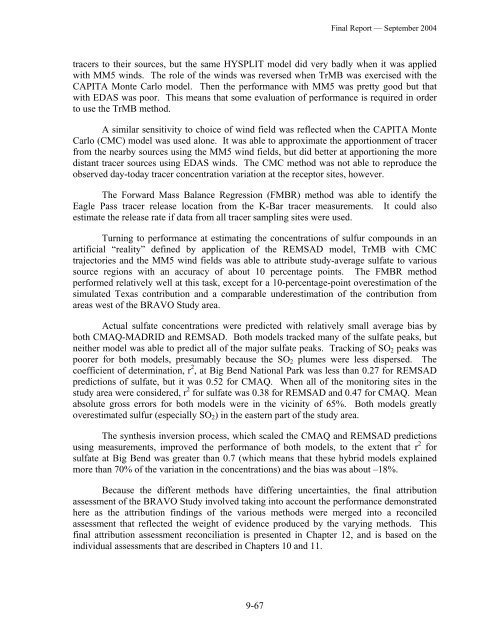(BRAVO) Study: Final Report. - Desert Research Institute
(BRAVO) Study: Final Report. - Desert Research Institute
(BRAVO) Study: Final Report. - Desert Research Institute
Create successful ePaper yourself
Turn your PDF publications into a flip-book with our unique Google optimized e-Paper software.
<strong>Final</strong> <strong>Report</strong> — September 2004<br />
tracers to their sources, but the same HYSPLIT model did very badly when it was applied<br />
with MM5 winds. The role of the winds was reversed when TrMB was exercised with the<br />
CAPITA Monte Carlo model. Then the performance with MM5 was pretty good but that<br />
with EDAS was poor. This means that some evaluation of performance is required in order<br />
to use the TrMB method.<br />
A similar sensitivity to choice of wind field was reflected when the CAPITA Monte<br />
Carlo (CMC) model was used alone. It was able to approximate the apportionment of tracer<br />
from the nearby sources using the MM5 wind fields, but did better at apportioning the more<br />
distant tracer sources using EDAS winds. The CMC method was not able to reproduce the<br />
observed day-today tracer concentration variation at the receptor sites, however.<br />
The Forward Mass Balance Regression (FMBR) method was able to identify the<br />
Eagle Pass tracer release location from the K-Bar tracer measurements. It could also<br />
estimate the release rate if data from all tracer sampling sites were used.<br />
Turning to performance at estimating the concentrations of sulfur compounds in an<br />
artificial “reality” defined by application of the REMSAD model, TrMB with CMC<br />
trajectories and the MM5 wind fields was able to attribute study-average sulfate to various<br />
source regions with an accuracy of about 10 percentage points. The FMBR method<br />
performed relatively well at this task, except for a 10-percentage-point overestimation of the<br />
simulated Texas contribution and a comparable underestimation of the contribution from<br />
areas west of the <strong>BRAVO</strong> <strong>Study</strong> area.<br />
Actual sulfate concentrations were predicted with relatively small average bias by<br />
both CMAQ-MADRID and REMSAD. Both models tracked many of the sulfate peaks, but<br />
neither model was able to predict all of the major sulfate peaks. Tracking of SO 2 peaks was<br />
poorer for both models, presumably because the SO 2 plumes were less dispersed. The<br />
coefficient of determination, r 2 , at Big Bend National Park was less than 0.27 for REMSAD<br />
predictions of sulfate, but it was 0.52 for CMAQ. When all of the monitoring sites in the<br />
study area were considered, r 2 for sulfate was 0.38 for REMSAD and 0.47 for CMAQ. Mean<br />
absolute gross errors for both models were in the vicinity of 65%. Both models greatly<br />
overestimated sulfur (especially SO 2 ) in the eastern part of the study area.<br />
The synthesis inversion process, which scaled the CMAQ and REMSAD predictions<br />
using measurements, improved the performance of both models, to the extent that r 2 for<br />
sulfate at Big Bend was greater than 0.7 (which means that these hybrid models explained<br />
more than 70% of the variation in the concentrations) and the bias was about –18%.<br />
Because the different methods have differing uncertainties, the final attribution<br />
assessment of the <strong>BRAVO</strong> <strong>Study</strong> involved taking into account the performance demonstrated<br />
here as the attribution findings of the various methods were merged into a reconciled<br />
assessment that reflected the weight of evidence produced by the varying methods. This<br />
final attribution assessment reconciliation is presented in Chapter 12, and is based on the<br />
individual assessments that are described in Chapters 10 and 11.<br />
9-67
















